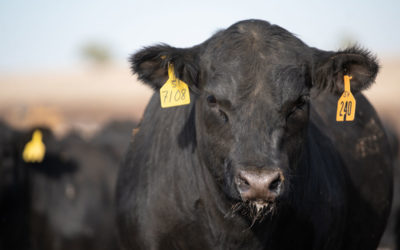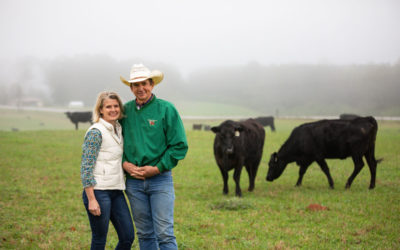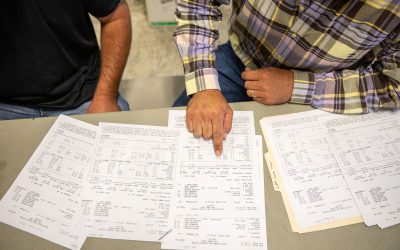
New calf marketing routes
Backgrounding can add value, flexibility
by Morgan Boecker
July 6, 2021
Effective calf marketing takes a plan or, as the pandemic made clear, a set of flexible plans. For the 70% or more of beef calves born last spring, producers had months to worry and hope for the best while preparing for worse. Come fall, more than the usual share veered from traditional roads to the feedyard.
Backgrounding those calves opened gates to several new revenue paths, though not without risk. Some calves always went to the grazing fields or growing yards. With more volume on those pathways, shifting seasonal patterns could be among the means toward improved marketing options.
Backgrounding adds value in three primary ways: 1) added weight, 2) delayed marketing, and 3) improved animal health.
Those with fall-calving cows now face similar decisions in a rapidly changing market, while those with new spring calves once again watch and plan, always prepared to deviate from traditional routes.
With smart gain, pounds rule
Boosting income may begin with adding weight, but that requires strategy, says Dan Loy, director of the Iowa Beef Center at Iowa State University. He suggests backgrounding the lighter half of steers to have reach heavier average sale weights
“If you market the heavier ones direct from weaning, and have done that for years, you’ll have a more uniform group,” he says. “That in itself may help the price on those heavier calves.”
Cow-calf producers often add 200 to 300 pounds (lb.) to weaned calves before sending them to a feedyard.
Seedstock producers find advantages in feeding those that don’t make it as bulls.
“Ours are straight Angus calves,” says Nathan Spickler, of Spickler Ranch South near Glenfield, N.D. “You can have high-quality females and steers that bring more income.”
Spickler says backgrounding calves not only boosts income, but offers a glimpse of their herd’s carcass merit.
Karl Hoppe, livestock systems extension specialist at North Dakota State University’s Carrington Research Extension Center, says producers should continue to feed cattle as long as the value of gain continues to be profitable.
“As long as the value of the additional gain is higher than the feed costs, plus yardage and other costs, we should keep feeding them,” Hoppe says.
Bawling calves may be too light to sell at weaning. Hoppe says it’s important to learn the cost of gain: divide feed cost by average daily gain (ADG). Watch costs closely and raise your own feed to gross more dollars per head, he suggests.
How much weight is enough?
“We can’t feed for a pound-a-day gain,” Hoppe says.
Taking into account all costs, 1.8 to 2.8 lb. ADG is achievable. More than that and calves get too fleshy, he says. Less than that and calves are too inefficient to earn profits.
Typically, a 550-lb. weaned steer needs to gain 250 lb., Hoppe says. At 2.5 lb. ADG it takes 100 days to reach 800 lb. That animal was worth $1,080 ($1.35/lb.) last at area auctions last September compared to $814 ($1.48/lb.) for the 550-pounder.
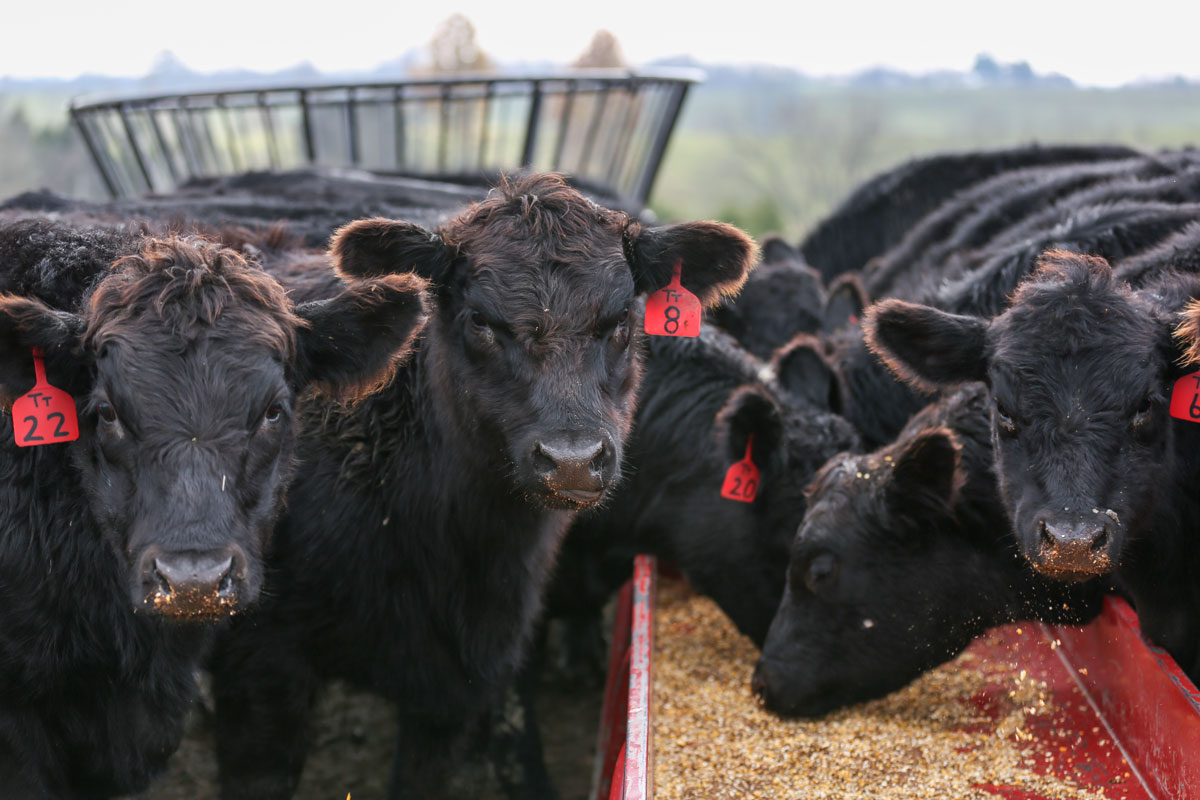
Home- or locally grown
Find feedstuffs that can produce that level of performance for steers, advises Dale Blasi, extension beef specialist at Kansas State University.
For properly developed replacement heifers, Loy would aim for 1.5 lb. ADG or stay on track to reach a target 60% of their mature weight at breeding. It’s more cost competitive to feed them separately.
“A lot of people I work with talk about walking their corn off the farm instead of selling it,” Blasi says. “They’re getting the market value of their corn by feeding it to cattle.”
Beef producers who can’t grow their own should seek affordable options. Buying grain will add other costs like handling and freight, but it can pay if the price is right.
Roughage, or digestible fiber, is good for stretching bellies but often lacks energy and protein, which means buying supplemental feed. Loy suggests looking for low-cost alternatives nearby from seed-corn factories, canneries and ethanol plants. Other areas may have wheat middlings, soy hulls, distillers grains or beet pulp.
Spickler has easy access to sunflower and corn screenings, pea hulls, split peas, and barley hulls, which make great supplements.
“We’re in the land of feed byproducts in North Dakota,” he says. “A lot of times it is quite a bit cheaper just to use the plethora of unique feeds we have available.”
Find the right team
If it seems overwhelming to add a backgrounding enterprise, don’t be afraid to hire expertise, says Chad Cargill, of Cargill Ranch LLC, Medicine Lodge, Kan. He provides services for larger cattle feeders at his custom yard, with help from a nutritionist, veterinarian and environmental consultant, plus pharmaceutical representatives.
“Use these people who are experts,” he says. “They’re really good at what they do and that allows us to do what we do – feeding and taking care of calves.
“You’re never going to reach perfection by feeding or doctoring,” Cargill says. “But if you’ve got people who are trying their hardest and keep everything consistent, you eliminate every variable that you can.”
“You have to look at your facilities,” Blasi adds. “Do you have the space to hold these calves for three or four months?”
What’s needed looks different for everyone, but staples are the same. Bunk space with some kind of concrete apron or a grass trap to lay feed that might be delivered with a mixer wagon, plus a chute and working facilities to vaccinate or treat sick calves.
“These resources are a substantial investment but necessary for successful backgrounding,” Blasi says.
Make it worth the wait
In the fall, there’s always the depression for calf prices at weaning time,” Hoppe says. “It’s economics 101, the greater supply means lower prices. But if you can wait to sell later, usually there will be higher prices.”
Genetics, lot size, weight uniformity, geography and market conditions affect those prices. Decisions and management can affect some of those factors at the ranch or grow yard, but others just depend on the market.
Backgrounding calves a few months can add weight and gross income without using more resources year-round to stock more cows.
But it can affect loan repayment, Hoppe says, so pencil out a budget and talk to the lender: “Unless you’ve got your cow herd paid for and money in the bank, it costs to own calves for another few months.”
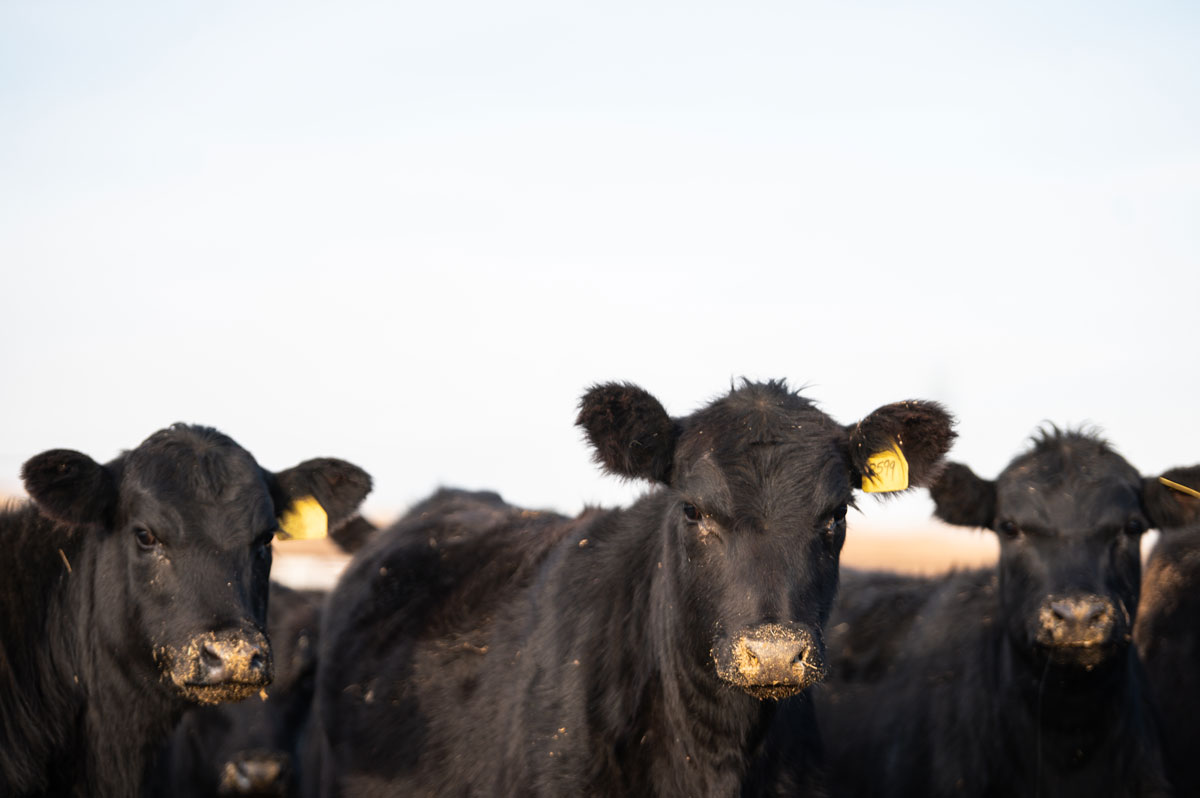
It also means delaying income, often affecting taxes.
“The first time you do this may double income in a certain year,” Loy says. “You want to work with your banker and your tax specialists, because there can be real implications for some producers.”
Project and include all production costs, like value of gain and cost of gain, even maintenance and depreciation, Blasi advises. Backgrounding may not be a competitive option if there’s too much death loss or high feed costs.
He points to an online tool called Beef Basis (beefbasis.com) that projects feed and cattle prices based on futures, which helps determine the costs and values needed to decide whether to try backgrounding.
Once the prices and costs are projected to everyone’s satisfaction, don’t forget to include such feedyard charges as labor, yardage, water, fuel and machinery costs.
High road to health
Health is often the highest concern for feedyards.
“To me, backgrounding should include preconditioning,” Loy says. “That verifies health and lets the vaccines kick in, plus getting calves eating out of a bunk and drinking from new waterers.”
The dollar-advantage of weaning is well established. Preconditioned calves vaccinated for respiratory and clostridial disease, treated for parasites and weaned for 45 days brought at least $50 per head more than unweaned contemporaries in 2020 data.
A low-stress weaning strategy helps get the calves off to a good start.
“I would encourage people to look at soft weaning on pasture,” Blasi says. “Get all of their pre-vaccination stuff done and through that tough hurdle during the first two to three weeks.”
Post-weaning management and marketing varies by region. The southeastern U.S. is known for order buyers combining small groups from numerous herds into load lots. Sometimes those calves have no vaccination history, so the buyer-backgrounding yards often mass-treat calves to halt emerging disease outbreaks.
Custom backgrounders often have relationships with larger cow-calf producers, auction markets and feedyards to find calves with similar genetics, size and weight to make a load lot, Cargill says.
His large-scale feedyard customers want calves healthy and ready in 45 to 60 days.
“Every load is different, so it’s hard to ever say you’ve figured these calves out,” he says.
Still, he works with his veterinarian to develop vaccination protocols and treatment plans when calves get sick. Most calves he receives are on loads freshly weaned from the Southeast. They enter his lot at high risk for respiratory illness. The issues are cumulative, often rooted in stress or poor feed.
“One issue is easy to handle, but those things together add up to bigger issues,” Cargill says.
As calves mature, their immunity improves. That’s important as natural and other process verified programs become popular.
Evolving demands
The most valuable feeder calf yesterday could be only average moving forward.
Buyers still look for groups with uniform weight and hide color, but verification is gaining importance. The market may soon require certified pre-weaned and vaccinated, age-source-and-genetics verified, records for performance and carcass history, along with animal welfare claims.
Cattle feeders seek reliable suppliers of quality calves. Many offer performance and carcass data in exchange for a relationship that may include various levels of ownership. Then they work on shared goals of improving the genetics and health of future calf crops.
“It’s all about risk and knowing what they’re getting,” Blasi says. “If you have any degree of carcass data—maybe you feed once with somebody and see how well your calves do—then you have a willing buyer in the future because they know the quality of the calves.”
When it’s time to head down a new road of marketing, learn from others who have made the trip before you, Blasi suggests.
Those are the lessons from peers and mentors, he adds. Participate in a marketing network, or join local and state beef association meetings to learn from each other.
Originally published in the Angus Beef Bullletin.
You may also like
Matchmaking the yard
Choosing a feedyard is a bit like selecting a life partner. Feedyards offer different marketing opportunities and strategies. A manager should be able to look at a customer’s pen and know, “I have a good market for those cattle. I can handle it.”
Find what works, stick to it
He’s a sixth generation farmer and grew up on a cattle farm and apple orchard. She’s a past chemistry teacher but now works full-time on the farm with her husband. Together, they closely manage their bottom line.
Your cattle, data and the grid
Many cattlemen have an idea of how grid marketing works, but might still have some questions as they’re digging through carcass data. Paul Dykstra will present a free webinar, “Understanding grid marketing and carcass data,” on January 21, 2021 at 1:30 p.m. CST.

